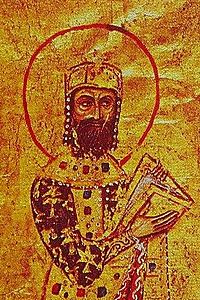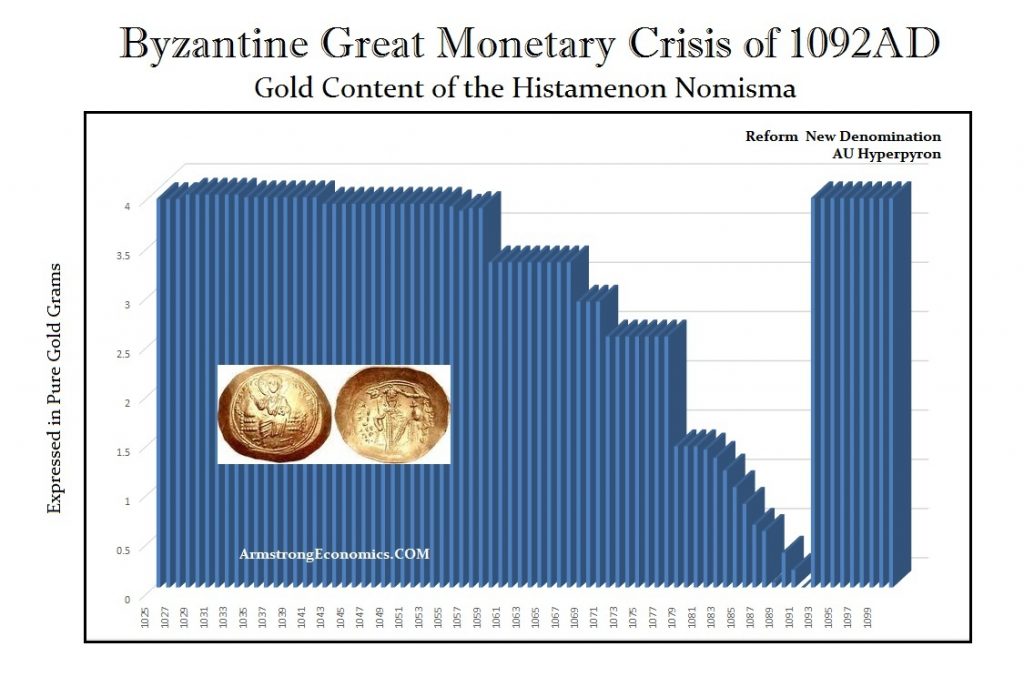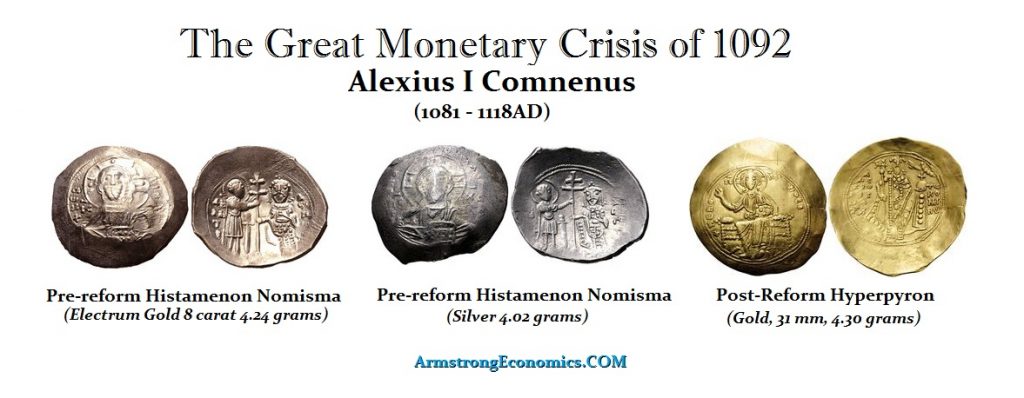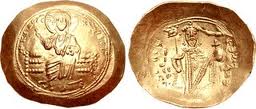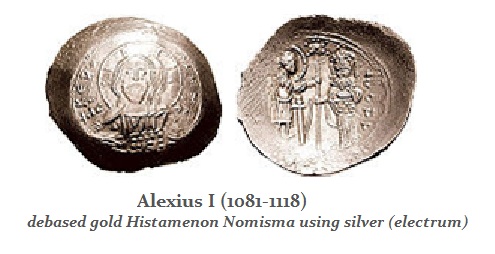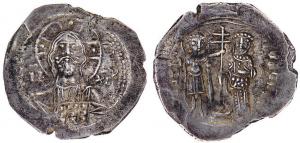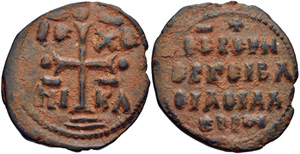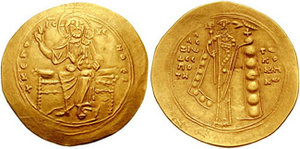Monetary History of
Byzantium
ALEXIUS I
1081-1118
Alexius I Comnenos (c. 1048; 1081 – 1118AD) was Byzantine emperor from 1081 to 1118 yet he inherited a collapsing empire. Byzantium faced constant warfare against Seljuq Turks in Asia Minor and the French in the western Balkans. Alexius also faced the collapsed on the monetary system. The debasement of the gold coinage began in 1068AD and impacted the gold for the first time. Rome debased the silver coinage and reduced the weight somewhat of the gold coinage, but they never debased the gold coinage in any material manner. In 1093, Alexius undertook a major reform of the monetary system which became known as the Comnenian restoration contemporarily. The basis for this recovery were various reforms initiated by Alexius. His appeals to Western Europe for help against the Turks set in motion the justification for the Crusades.
Alexius I had overcome a dangerous crisis both economically and militarily. For the first 11 years, Alexius I continued the practice of debasing the gold coinage. Eventually, in 1092, Alexius I was forced to revise the monetary system as the gold content of the coinage fell below 5%. In 1092, Alexius introduced a new denomination restoring the gold content to 90%. This eventually stabilized the Byzantine Empire, inaugurating a century of imperial prosperity and success. He had also profoundly altered the nature of the Byzantine government and sought to establish close alliances with powerful noble families. Alexius put an end to the tradition of imperial exclusivity and co-opted most of the nobility into his extended family and thus the government. Those who did not become part of this political family were deprived of power and prestige. In this way, Alexius intended to diminish any opposition. Although this policy met with initial success, it gradually undermined the relative effectiveness of imperial bureaucracy by placing family connections over merit – nepotism. Alexius’ policy of integration of the nobility continued with the subsequent rules that followed.

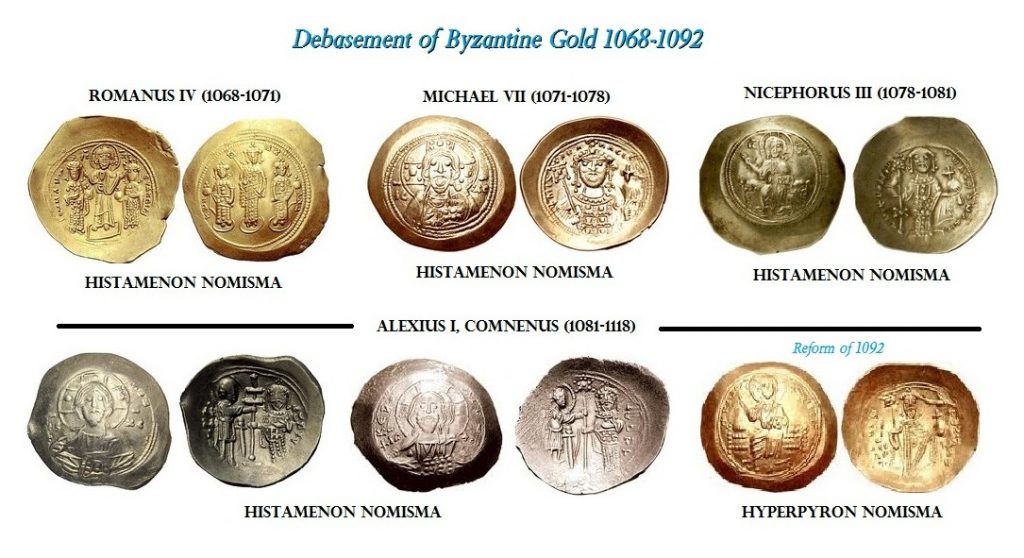
The collapse of the monetary system of the Byzantine Empire was unlike that the Romans. The Byzantines debased their gold coinage to the point what use to be gold became silver. The Great Monetary Crisis of 1092 involved the destruction of capital formation. The Byzantine Empire was in its decline with the peak in 1104 following the Monetary Crisis of 1092 and by 1204, the city of Constantinople falls to the Europeans, namely the Venetians and the French. Where the Romans debased the silver coinage and reduced the weight of the bronze coinage, they did not debase the gold coinage but did reduce its weight. In Constantinople, gold had been the unit of account and thus it was debased by adding silver. The gold coinage lost its color and by Alexius I (1081-1118) and the siege of Constantinople in 1090, what was once gold had been reduced to effective a silver coin. The Great Monetary Reform of 1092, introduced the Hyperpyron Nomisma meaning fine gold in an effort to restore the economy.
The major debasement of the Byzantine coinage had begun under Constantine IX Monomachos (1042-1055), with the purity of the gold coinage falling from 24 carats to 18 carats during his reign. In 1041, the year before he came to the throne, the Histamenon Nomisma had a weight of about 3.96 grams with a gold content of about 90%. The very first year in 1042, the gold content was reduced to 87.5%. Constantine IX did not take his responsibilities as Emperor very seriously. He seems to have assumed that the wealth of the nation was his to spend as he desired. He squandered money profoundly and this appears to have been the initial reason for the beginning of the debasement. The gold nomisma fell to 87%. Constantine IX died in 1055 and there were no heirs. The last surviving member of the Macedonian line assumed the throne, Theodora (1055-1056) but she died after 20 months. She nominated her successor Michael Stratioticus (1056-1057) who was not qualified. The military rose up and nominated Isacc Comnenus (1057-1059) as a rival emperor. As further discontent arose, Michael was forced to abdicate.
Isacc Comnenus was of the military aristocracy and as such, he turned to strengthen the defenses of the Empire. The treasury had been seriously depleted under Constantine IX and as such, Isacc turned to confiscate Church property, which obviously led to a conflict with the Patriarch of Constantinople. Isacc had the Patriarch arrested on charges of heresy to justify his confiscation. Conveniently, the Patriarch, Michael Cerularius, died before any trial. The people were incensed by Isacc’s attack on the Church and the death of the Patriarch that he was forced to abdicate after just 28 months of rule. The civil aristocracy regained power and installed Constantine X, Ducas (1059-1067), whose wife was the niece of the late Patriarch.
With a civil aristocrat on the throne, Byzantium was not able to deal with the rising forces around the Empire in search of conquest. Constantine X in 1059 reduced the gold content of the Histamenon Nomisma to 75%. There were virtually three invasions on separate fronts that emerged almost simultaneously. From the West came the Normans invading Italy. The Balkans were invaded by the Turks and Asia Minor was besieged by the Seljug power. The Empire nearly fell and the expense further depleted the treasury and contributed to the continued debasement. On the death of Isacc, his wife took the throne, Eudocia who ruled from May 21st, 1067 until December 31st that year. She assumed the regency on behalf of her two young sons and the civil aristocrats further reduced the gold content of the coinage in 1068 to 66.7%. With the empire under attack, she was compelled to marry a competent husband to take charge, Romanus IV, Diogenes (1069-1071) who was a highly distinguished military general.
Romanus IV attempted to defend Asia Minor (Turkey). However, he lacked even the troops. He was forced to hire mercenaries which further depleted the gold reserves. He attacked the Seljuqs but he suffered a devastating defeat and was himself captured. The civil aristocrats used the opportunity to reestablish Eudocia on the throne with her eldest son Michael Ducas who they assumed they could control. That corruption to control the throne lasted only two months and Eudocia was told to retire to a nunnery. Michael VII (1071-1078) would now be totally controlled by the aristocrat Michael Psellius, who once again reduced the gold content of the Histamenon Nomisma to 58% in 1071.
A treaty with the Sejugs was achieved in 1072 and they released Romanus IV. However, to prevent his attempt to regain the throne, Michael Psellius order that Romanus should be blinded by burning his eyes out and he died soon thereafter. The Seljuqs used this as the justification the attack once again. The Seljuqs invaded and captured the heartland of Byzantium leaving little more than just Constantinople itself. The Normans took Italy and the Balkans were virtually lost. The corruption of the civil aristocracy led to a rebellion and the general Nicephorus III Botaniates (1078-1081) forced the puppet emperor to retire. The treasury was depleted and the access to mints was cut off. The gold Histamenon Nomisma under Nicephorus III had fallen in content to 33% in 1078. There were at least two attempts to overthrow Nicephorus III and his general, Alexius I Comnenus defended the throne. However, when Alexius’ brother-in-law rebelled, he joined him and the people opened the gates to Constantinople. Nicephorus III, without support, abdicated the throne.
When Alexius I came to the throne, the debasement of each new emperor seemed to become a tradition. In 1082, we see that Alexius I debased the Histamenon Nomisma to a 31% gold content. The next year, 1083, the gold content was reduced further to 28% followed by 24% in 1084, 20% in 1085, 15% in 1086, 13.5% during 1087, 12.5% in 1088, then 8.33% in 1089, with a dramatic collapse to 4.16% in 1090. It was the Great Monetary Crisis of 1092 that forced Alexius I to restore the gold coinage to 90% introducing a new denomination known as the Hyperpyron with a wight of about 4.3 grams.
What is important is that at the beginning of Alexius’s reign the economic situation had deteriorated, with the state becoming increasingly impoverished as reflected in the pressure for further debasements. Mint production can be split into two phases, as can the monetary policy: pre-reform and post-reform. In the pre-reform period, the main mint was Constantinople, with another being set up at Thessaloniki early in Alexios’s reign. This mint had been inactive up until Alexius’s accession, but it began minting coins again in 1081. It is believed that the mint was established in September 1081. Additionally, this mint was established for military purposes. Therefore, judging from the date of its opening and its location in Thessaloniki, the mint may have been set up as an emergency mint to provide coins for the army needed to fight the Normans.
Post-reform Constantinople remained the main mint for coinage, with Thessaloniki striking coins only in gold and electrum which would have been used to pay soldiers. Apart from these two major mints, another two are believed to have been established post-reform in order to mint gold or billion coins, one located at Philippopolis and another at an unknown site. It has also been suggested that there was a mint in Greece at Thebes, producing copper half-tetartera. When the matter of quantity is addressed it is impossible to produce an accurate figure, especially for non-precious metal coinage, however, D. M. Metcalf, D.M (Coinage in South-eastern Europe, 820-1396), has estimated the number of hyperpyra struck in the post-reform period to be about 8-10 million.
Monetary System
DENOMINATIONS
Note: It was during the Reign of Alexius that the First Crusades began
Pre-Reform 1081-1092
ELectrum Histamenon Nomisma (Christ/Alexius+St Demetrius)
ELectrum Histamenon Nomisma (Enthroned Christ/Alexius stg)
EL Histamenon Nomisma (Christ/Alexius+St Demetrius)
AR Histamenon Nomisma (Christ/Alexius facing)
ELectrum Tetarteron Nomisma (Christ/Alexius)
ELectrum Tetarteron Nomisma (Christ stg/Alexius stg)
AR Tetarteron Nomisma (Christ/Alexius)
AR Miliaresion (Virgin/Alexius standing)
AR 2/3 Miliaresion (Virgin+infant/6 lines text)
AR 1/2 Miliaresion (Christ/Alexius St Demetrius)
AR 1/3 Miliaresion (Virgin+infant/4 lines text)
AE Follis (Christ/Cross)
AE Follis (Virgin+infant/Alexius stg) Thessalonica
AE Follis (Cross/4 lines text) Thessalonica
Post-Reform Great Monetary Crisis of 1092 marked the introduction of gold at 20k which last until 12th century
Hyperpyron = 3 Electrum Aspron Trachy = 48 Billon Aspron Trachy = ? AE Tetarteron
AU Hyperpyron (Christ enthroned/Alexius facing)
EL Aspron Trachy (Virgin+Infant throne/Alexius stg) = 1/3 Hyper
Billon Aspron Trachy (Christ enthroned/Alexius stg) = 1/48 Hyper
AE Tetarteron (Christ/Alexius) =?
AE Tetarteron (Virgin/Alexius) Thessalonica
AE 1/2 Tetarteron (Virgin/Alexius) Thessalonica
Monetary History of the World
© by Martin A. Armstrong
Last Update 11/01/97

